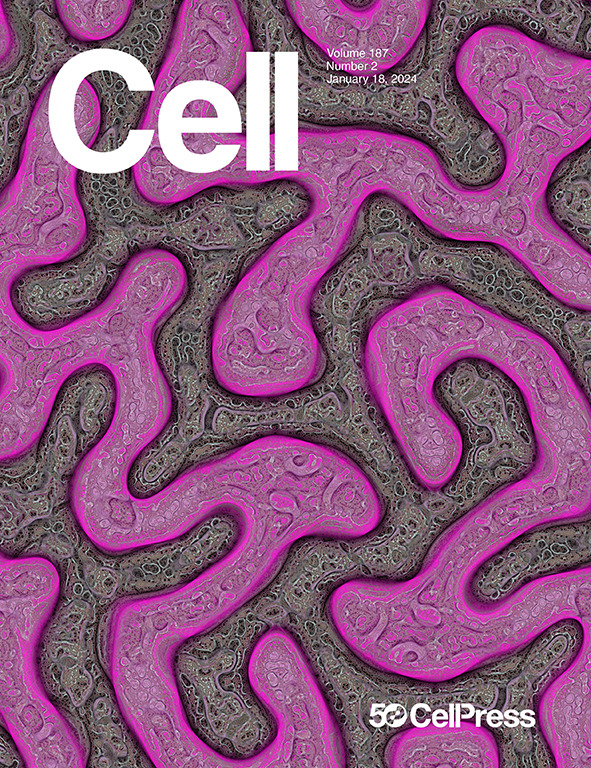TnsABCD 转座子的结构揭示了定向 DNA 转座的机制
IF 45.5
1区 生物学
Q1 BIOCHEMISTRY & MOLECULAR BIOLOGY
引用次数: 0
摘要
Tn7 类转座子的特点是能够特异性地插入宿主染色体。TnsD 识别附着(att)位点后,会招募 TnsABC 蛋白形成转座子并促进转座。虽然这一途径已被充分证实,但对这一过程的原子级结构研究在很大程度上仍是空白。在这里,我们展示了 TnsC-TnsD-att DNA 复合物和 TnsABCD 转座子的冷冻电子显微镜(cryo-EM)结构,这些复合物和转座子来自 Peltigera membranacea cyanobiont 210A 中的 Tn7 样转座子,这是一种 I-B 型 CRISPR 相关转座子。我们的结构显示,TnsD 的精氨酸侧链插入了 CC/GG 二核苷酸阶梯,从而使 att DNA 发生了明显的弯曲。TnsABCD 转座子结构揭示了 TnsA-TnsB 的相互作用,并证明 TnsC 不仅能招募 TnsAB,还能直接参与转座子的组装。这些发现从机理上揭示了 Tn7 类转座子的定向 DNA 插入,对提高基因组编辑应用的精确性和效率具有重要意义。本文章由计算机程序翻译,如有差异,请以英文原文为准。

Structure of TnsABCD transpososome reveals mechanisms of targeted DNA transposition
Tn7-like transposons are characterized by their ability to insert specifically into host chromosomes. Recognition of the attachment (att) site by TnsD recruits the TnsABC proteins to form the transpososome and facilitate transposition. Although this pathway is well established, atomic-level structural insights of this process remain largely elusive. Here, we present the cryo-electron microscopy (cryo-EM) structures of the TnsC-TnsD-att DNA complex and the TnsABCD transpososome from the Tn7-like transposon in Peltigera membranacea cyanobiont 210A, a type I-B CRISPR-associated transposon. Our structures reveal a striking bending of the att DNA, featured by the intercalation of an arginine side chain of TnsD into a CC/GG dinucleotide step. The TnsABCD transpososome structure reveals TnsA-TnsB interactions and demonstrates that TnsC not only recruits TnsAB but also directly participates in the transpososome assembly. These findings provide mechanistic insights into targeted DNA insertion by Tn7-like transposons, with implications for improving the precision and efficiency of their genome-editing applications.
求助全文
通过发布文献求助,成功后即可免费获取论文全文。
去求助
来源期刊

Cell
生物-生化与分子生物学
CiteScore
110.00
自引率
0.80%
发文量
396
审稿时长
2 months
期刊介绍:
Cells is an international, peer-reviewed, open access journal that focuses on cell biology, molecular biology, and biophysics. It is affiliated with several societies, including the Spanish Society for Biochemistry and Molecular Biology (SEBBM), Nordic Autophagy Society (NAS), Spanish Society of Hematology and Hemotherapy (SEHH), and Society for Regenerative Medicine (Russian Federation) (RPO).
The journal publishes research findings of significant importance in various areas of experimental biology, such as cell biology, molecular biology, neuroscience, immunology, virology, microbiology, cancer, human genetics, systems biology, signaling, and disease mechanisms and therapeutics. The primary criterion for considering papers is whether the results contribute to significant conceptual advances or raise thought-provoking questions and hypotheses related to interesting and important biological inquiries.
In addition to primary research articles presented in four formats, Cells also features review and opinion articles in its "leading edge" section, discussing recent research advancements and topics of interest to its wide readership.
 求助内容:
求助内容: 应助结果提醒方式:
应助结果提醒方式:


